Singapore University: Intellectual Property Rights Assignment, GSP171e
VerifiedAdded on 2023/06/08
|6
|1502
|384
Homework Assignment
AI Summary
This assignment solution addresses intellectual property rights in the context of Singapore law. It analyzes the protection afforded by patents, copyrights, trademarks, and trade secrets to software. The solution explores different forms of intellectual property infringement, including patent, copyright, and trademark violations, along with available legal remedies such as injunctions, damages, and compensation. The assignment also differentiates between IP licenses and assignments, highlighting the transfer of ownership and the implications of each. It recommends the appropriate course of action for a given scenario, emphasizing the benefits of assignment over licensing for comprehensive control. Finally, the solution references relevant case law and academic sources.
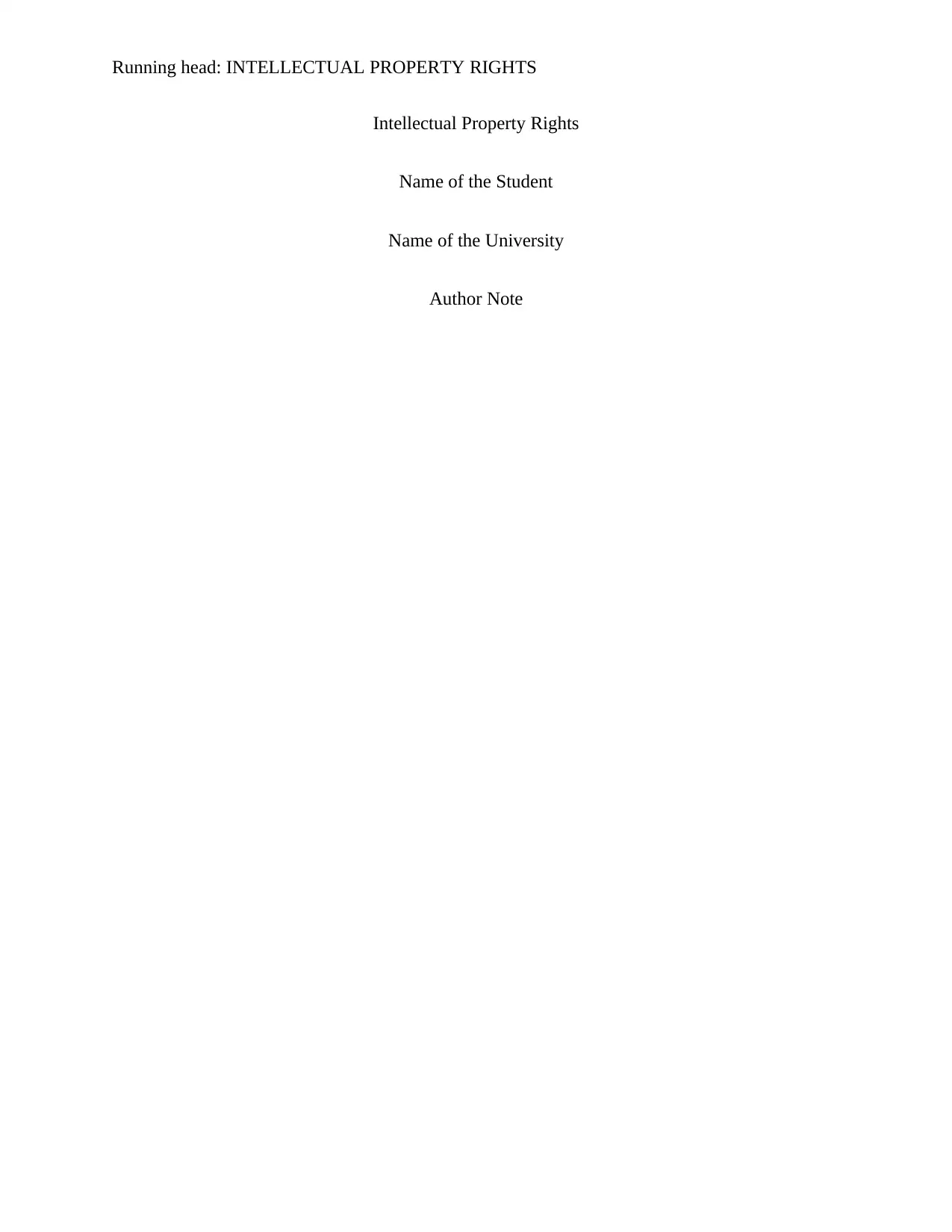
Running head: INTELLECTUAL PROPERTY RIGHTS
Intellectual Property Rights
Name of the Student
Name of the University
Author Note
Intellectual Property Rights
Name of the Student
Name of the University
Author Note
Paraphrase This Document
Need a fresh take? Get an instant paraphrase of this document with our AI Paraphraser
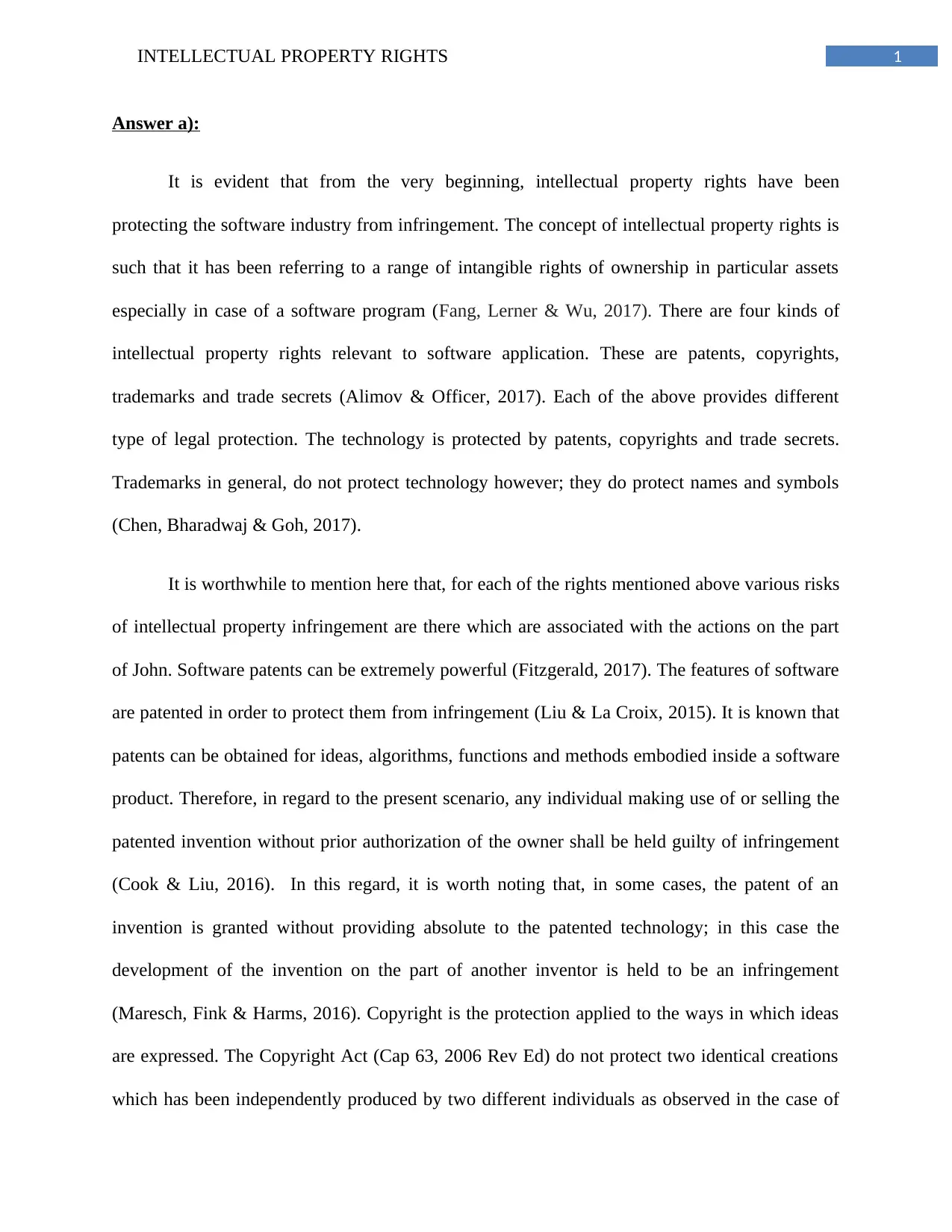
1INTELLECTUAL PROPERTY RIGHTS
Answer a):
It is evident that from the very beginning, intellectual property rights have been
protecting the software industry from infringement. The concept of intellectual property rights is
such that it has been referring to a range of intangible rights of ownership in particular assets
especially in case of a software program (Fang, Lerner & Wu, 2017). There are four kinds of
intellectual property rights relevant to software application. These are patents, copyrights,
trademarks and trade secrets (Alimov & Officer, 2017). Each of the above provides different
type of legal protection. The technology is protected by patents, copyrights and trade secrets.
Trademarks in general, do not protect technology however; they do protect names and symbols
(Chen, Bharadwaj & Goh, 2017).
It is worthwhile to mention here that, for each of the rights mentioned above various risks
of intellectual property infringement are there which are associated with the actions on the part
of John. Software patents can be extremely powerful (Fitzgerald, 2017). The features of software
are patented in order to protect them from infringement (Liu & La Croix, 2015). It is known that
patents can be obtained for ideas, algorithms, functions and methods embodied inside a software
product. Therefore, in regard to the present scenario, any individual making use of or selling the
patented invention without prior authorization of the owner shall be held guilty of infringement
(Cook & Liu, 2016). In this regard, it is worth noting that, in some cases, the patent of an
invention is granted without providing absolute to the patented technology; in this case the
development of the invention on the part of another inventor is held to be an infringement
(Maresch, Fink & Harms, 2016). Copyright is the protection applied to the ways in which ideas
are expressed. The Copyright Act (Cap 63, 2006 Rev Ed) do not protect two identical creations
which has been independently produced by two different individuals as observed in the case of
Answer a):
It is evident that from the very beginning, intellectual property rights have been
protecting the software industry from infringement. The concept of intellectual property rights is
such that it has been referring to a range of intangible rights of ownership in particular assets
especially in case of a software program (Fang, Lerner & Wu, 2017). There are four kinds of
intellectual property rights relevant to software application. These are patents, copyrights,
trademarks and trade secrets (Alimov & Officer, 2017). Each of the above provides different
type of legal protection. The technology is protected by patents, copyrights and trade secrets.
Trademarks in general, do not protect technology however; they do protect names and symbols
(Chen, Bharadwaj & Goh, 2017).
It is worthwhile to mention here that, for each of the rights mentioned above various risks
of intellectual property infringement are there which are associated with the actions on the part
of John. Software patents can be extremely powerful (Fitzgerald, 2017). The features of software
are patented in order to protect them from infringement (Liu & La Croix, 2015). It is known that
patents can be obtained for ideas, algorithms, functions and methods embodied inside a software
product. Therefore, in regard to the present scenario, any individual making use of or selling the
patented invention without prior authorization of the owner shall be held guilty of infringement
(Cook & Liu, 2016). In this regard, it is worth noting that, in some cases, the patent of an
invention is granted without providing absolute to the patented technology; in this case the
development of the invention on the part of another inventor is held to be an infringement
(Maresch, Fink & Harms, 2016). Copyright is the protection applied to the ways in which ideas
are expressed. The Copyright Act (Cap 63, 2006 Rev Ed) do not protect two identical creations
which has been independently produced by two different individuals as observed in the case of

2INTELLECTUAL PROPERTY RIGHTS
Chua Puay Kiang v Singapore Telecommunications Limited [1999] 1 SLR(R) and Virtual Map
Singapore Pte Ltd v Singapore Land Authority and Another Application [2009] 2 SLR(R) 558.
It is evident that John adopted the TripOwl as the logo however used it in an inverted form. In
this regard, John has infringed the mark. Therefore, as a result of such unauthorized use of
trademark in connection to goods and services it creates confusion and deception regarding the
sources of the goods and services.
Various legal remedies are available on the part of the Courts of Singapore in cases
involving infringement of intellectual property rights. The remedies can be emphasized as
injunctions, damages, accounts of profits and compensation (Czarnitzki, Hussinger & Schneider,
2015). In case of infringement of copyright, trademark and patents, the owner of the intellectual
property can elect for an award of statutory damages. In this regard the Court can grant an
amount not exceeding $ 10,000 however; if it is proved that the intellectual property was
infringed then the Court is at the authority to grant an amount of $ 200,000. In this context, the
Court shall rely upon a number of factors which can be categorized as-
The nature of the infringing acts on the part of the individual whether it was personal or
commercial.
The circumstances that whether the defendant has acted in bad faith.
The loss suffered by the plaintiff as a result of such infringement.
Answer b):
Firstly, the major differences between an IP license and assignment are concerned with
the interest vested on the intellectual property (Maresch, Fink & Harms, 2016). Therefore, when
any individual is licensing any IP to another then in that case, permission is granted to utilize the
Chua Puay Kiang v Singapore Telecommunications Limited [1999] 1 SLR(R) and Virtual Map
Singapore Pte Ltd v Singapore Land Authority and Another Application [2009] 2 SLR(R) 558.
It is evident that John adopted the TripOwl as the logo however used it in an inverted form. In
this regard, John has infringed the mark. Therefore, as a result of such unauthorized use of
trademark in connection to goods and services it creates confusion and deception regarding the
sources of the goods and services.
Various legal remedies are available on the part of the Courts of Singapore in cases
involving infringement of intellectual property rights. The remedies can be emphasized as
injunctions, damages, accounts of profits and compensation (Czarnitzki, Hussinger & Schneider,
2015). In case of infringement of copyright, trademark and patents, the owner of the intellectual
property can elect for an award of statutory damages. In this regard the Court can grant an
amount not exceeding $ 10,000 however; if it is proved that the intellectual property was
infringed then the Court is at the authority to grant an amount of $ 200,000. In this context, the
Court shall rely upon a number of factors which can be categorized as-
The nature of the infringing acts on the part of the individual whether it was personal or
commercial.
The circumstances that whether the defendant has acted in bad faith.
The loss suffered by the plaintiff as a result of such infringement.
Answer b):
Firstly, the major differences between an IP license and assignment are concerned with
the interest vested on the intellectual property (Maresch, Fink & Harms, 2016). Therefore, when
any individual is licensing any IP to another then in that case, permission is granted to utilize the
⊘ This is a preview!⊘
Do you want full access?
Subscribe today to unlock all pages.

Trusted by 1+ million students worldwide
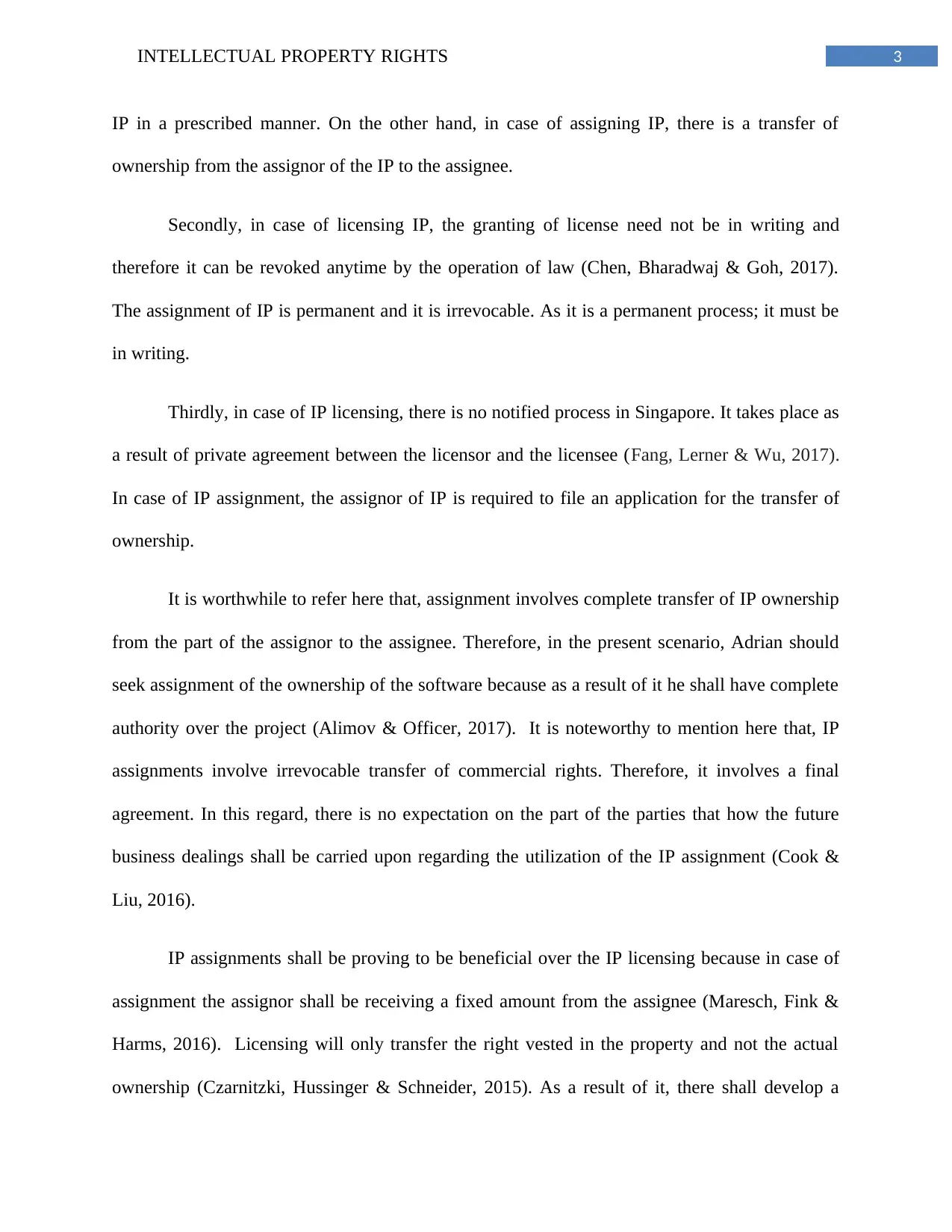
3INTELLECTUAL PROPERTY RIGHTS
IP in a prescribed manner. On the other hand, in case of assigning IP, there is a transfer of
ownership from the assignor of the IP to the assignee.
Secondly, in case of licensing IP, the granting of license need not be in writing and
therefore it can be revoked anytime by the operation of law (Chen, Bharadwaj & Goh, 2017).
The assignment of IP is permanent and it is irrevocable. As it is a permanent process; it must be
in writing.
Thirdly, in case of IP licensing, there is no notified process in Singapore. It takes place as
a result of private agreement between the licensor and the licensee (Fang, Lerner & Wu, 2017).
In case of IP assignment, the assignor of IP is required to file an application for the transfer of
ownership.
It is worthwhile to refer here that, assignment involves complete transfer of IP ownership
from the part of the assignor to the assignee. Therefore, in the present scenario, Adrian should
seek assignment of the ownership of the software because as a result of it he shall have complete
authority over the project (Alimov & Officer, 2017). It is noteworthy to mention here that, IP
assignments involve irrevocable transfer of commercial rights. Therefore, it involves a final
agreement. In this regard, there is no expectation on the part of the parties that how the future
business dealings shall be carried upon regarding the utilization of the IP assignment (Cook &
Liu, 2016).
IP assignments shall be proving to be beneficial over the IP licensing because in case of
assignment the assignor shall be receiving a fixed amount from the assignee (Maresch, Fink &
Harms, 2016). Licensing will only transfer the right vested in the property and not the actual
ownership (Czarnitzki, Hussinger & Schneider, 2015). As a result of it, there shall develop a
IP in a prescribed manner. On the other hand, in case of assigning IP, there is a transfer of
ownership from the assignor of the IP to the assignee.
Secondly, in case of licensing IP, the granting of license need not be in writing and
therefore it can be revoked anytime by the operation of law (Chen, Bharadwaj & Goh, 2017).
The assignment of IP is permanent and it is irrevocable. As it is a permanent process; it must be
in writing.
Thirdly, in case of IP licensing, there is no notified process in Singapore. It takes place as
a result of private agreement between the licensor and the licensee (Fang, Lerner & Wu, 2017).
In case of IP assignment, the assignor of IP is required to file an application for the transfer of
ownership.
It is worthwhile to refer here that, assignment involves complete transfer of IP ownership
from the part of the assignor to the assignee. Therefore, in the present scenario, Adrian should
seek assignment of the ownership of the software because as a result of it he shall have complete
authority over the project (Alimov & Officer, 2017). It is noteworthy to mention here that, IP
assignments involve irrevocable transfer of commercial rights. Therefore, it involves a final
agreement. In this regard, there is no expectation on the part of the parties that how the future
business dealings shall be carried upon regarding the utilization of the IP assignment (Cook &
Liu, 2016).
IP assignments shall be proving to be beneficial over the IP licensing because in case of
assignment the assignor shall be receiving a fixed amount from the assignee (Maresch, Fink &
Harms, 2016). Licensing will only transfer the right vested in the property and not the actual
ownership (Czarnitzki, Hussinger & Schneider, 2015). As a result of it, there shall develop a
Paraphrase This Document
Need a fresh take? Get an instant paraphrase of this document with our AI Paraphraser
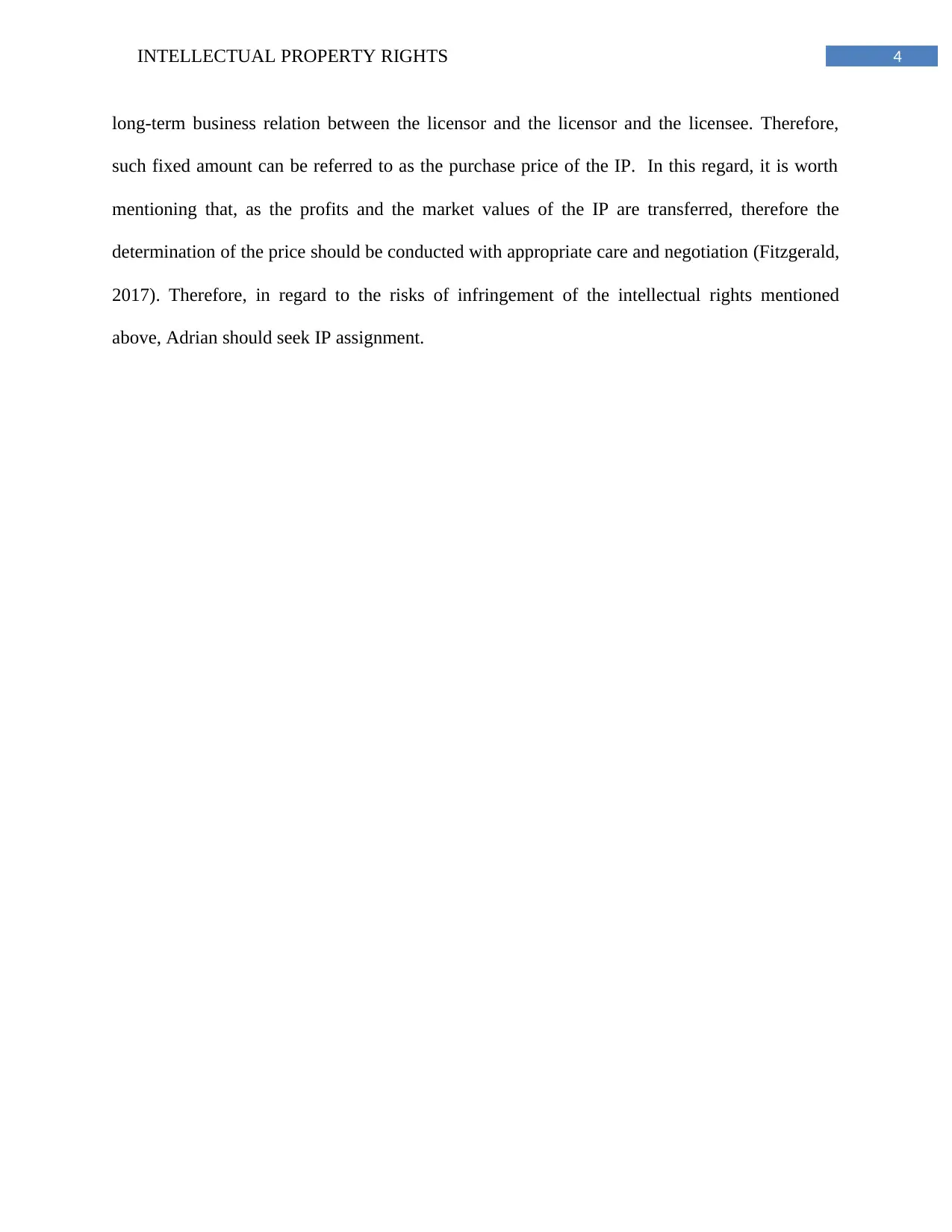
4INTELLECTUAL PROPERTY RIGHTS
long-term business relation between the licensor and the licensor and the licensee. Therefore,
such fixed amount can be referred to as the purchase price of the IP. In this regard, it is worth
mentioning that, as the profits and the market values of the IP are transferred, therefore the
determination of the price should be conducted with appropriate care and negotiation (Fitzgerald,
2017). Therefore, in regard to the risks of infringement of the intellectual rights mentioned
above, Adrian should seek IP assignment.
long-term business relation between the licensor and the licensor and the licensee. Therefore,
such fixed amount can be referred to as the purchase price of the IP. In this regard, it is worth
mentioning that, as the profits and the market values of the IP are transferred, therefore the
determination of the price should be conducted with appropriate care and negotiation (Fitzgerald,
2017). Therefore, in regard to the risks of infringement of the intellectual rights mentioned
above, Adrian should seek IP assignment.
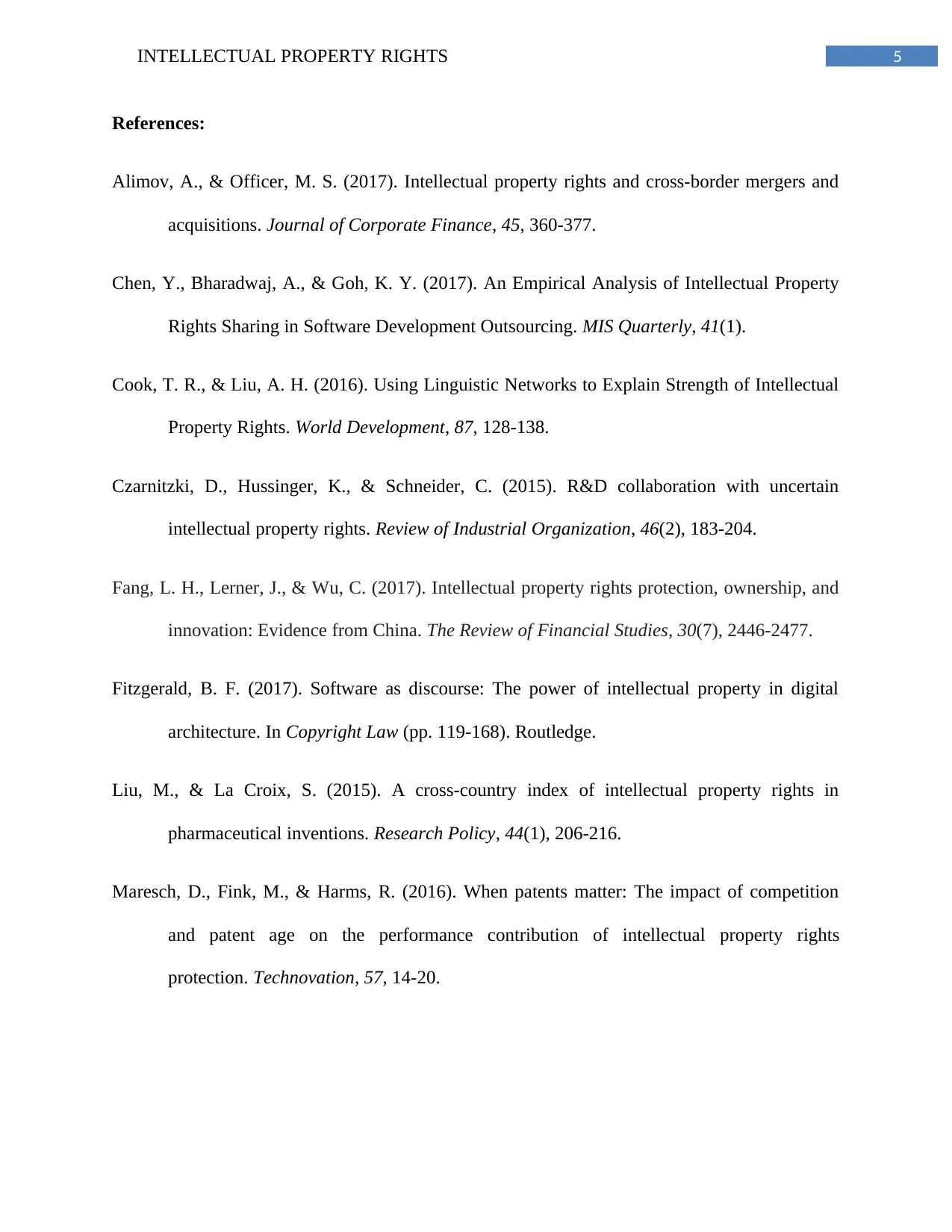
5INTELLECTUAL PROPERTY RIGHTS
References:
Alimov, A., & Officer, M. S. (2017). Intellectual property rights and cross-border mergers and
acquisitions. Journal of Corporate Finance, 45, 360-377.
Chen, Y., Bharadwaj, A., & Goh, K. Y. (2017). An Empirical Analysis of Intellectual Property
Rights Sharing in Software Development Outsourcing. MIS Quarterly, 41(1).
Cook, T. R., & Liu, A. H. (2016). Using Linguistic Networks to Explain Strength of Intellectual
Property Rights. World Development, 87, 128-138.
Czarnitzki, D., Hussinger, K., & Schneider, C. (2015). R&D collaboration with uncertain
intellectual property rights. Review of Industrial Organization, 46(2), 183-204.
Fang, L. H., Lerner, J., & Wu, C. (2017). Intellectual property rights protection, ownership, and
innovation: Evidence from China. The Review of Financial Studies, 30(7), 2446-2477.
Fitzgerald, B. F. (2017). Software as discourse: The power of intellectual property in digital
architecture. In Copyright Law (pp. 119-168). Routledge.
Liu, M., & La Croix, S. (2015). A cross-country index of intellectual property rights in
pharmaceutical inventions. Research Policy, 44(1), 206-216.
Maresch, D., Fink, M., & Harms, R. (2016). When patents matter: The impact of competition
and patent age on the performance contribution of intellectual property rights
protection. Technovation, 57, 14-20.
References:
Alimov, A., & Officer, M. S. (2017). Intellectual property rights and cross-border mergers and
acquisitions. Journal of Corporate Finance, 45, 360-377.
Chen, Y., Bharadwaj, A., & Goh, K. Y. (2017). An Empirical Analysis of Intellectual Property
Rights Sharing in Software Development Outsourcing. MIS Quarterly, 41(1).
Cook, T. R., & Liu, A. H. (2016). Using Linguistic Networks to Explain Strength of Intellectual
Property Rights. World Development, 87, 128-138.
Czarnitzki, D., Hussinger, K., & Schneider, C. (2015). R&D collaboration with uncertain
intellectual property rights. Review of Industrial Organization, 46(2), 183-204.
Fang, L. H., Lerner, J., & Wu, C. (2017). Intellectual property rights protection, ownership, and
innovation: Evidence from China. The Review of Financial Studies, 30(7), 2446-2477.
Fitzgerald, B. F. (2017). Software as discourse: The power of intellectual property in digital
architecture. In Copyright Law (pp. 119-168). Routledge.
Liu, M., & La Croix, S. (2015). A cross-country index of intellectual property rights in
pharmaceutical inventions. Research Policy, 44(1), 206-216.
Maresch, D., Fink, M., & Harms, R. (2016). When patents matter: The impact of competition
and patent age on the performance contribution of intellectual property rights
protection. Technovation, 57, 14-20.
⊘ This is a preview!⊘
Do you want full access?
Subscribe today to unlock all pages.

Trusted by 1+ million students worldwide
1 out of 6
Related Documents
Your All-in-One AI-Powered Toolkit for Academic Success.
+13062052269
info@desklib.com
Available 24*7 on WhatsApp / Email
![[object Object]](/_next/static/media/star-bottom.7253800d.svg)
Unlock your academic potential
Copyright © 2020–2025 A2Z Services. All Rights Reserved. Developed and managed by ZUCOL.




